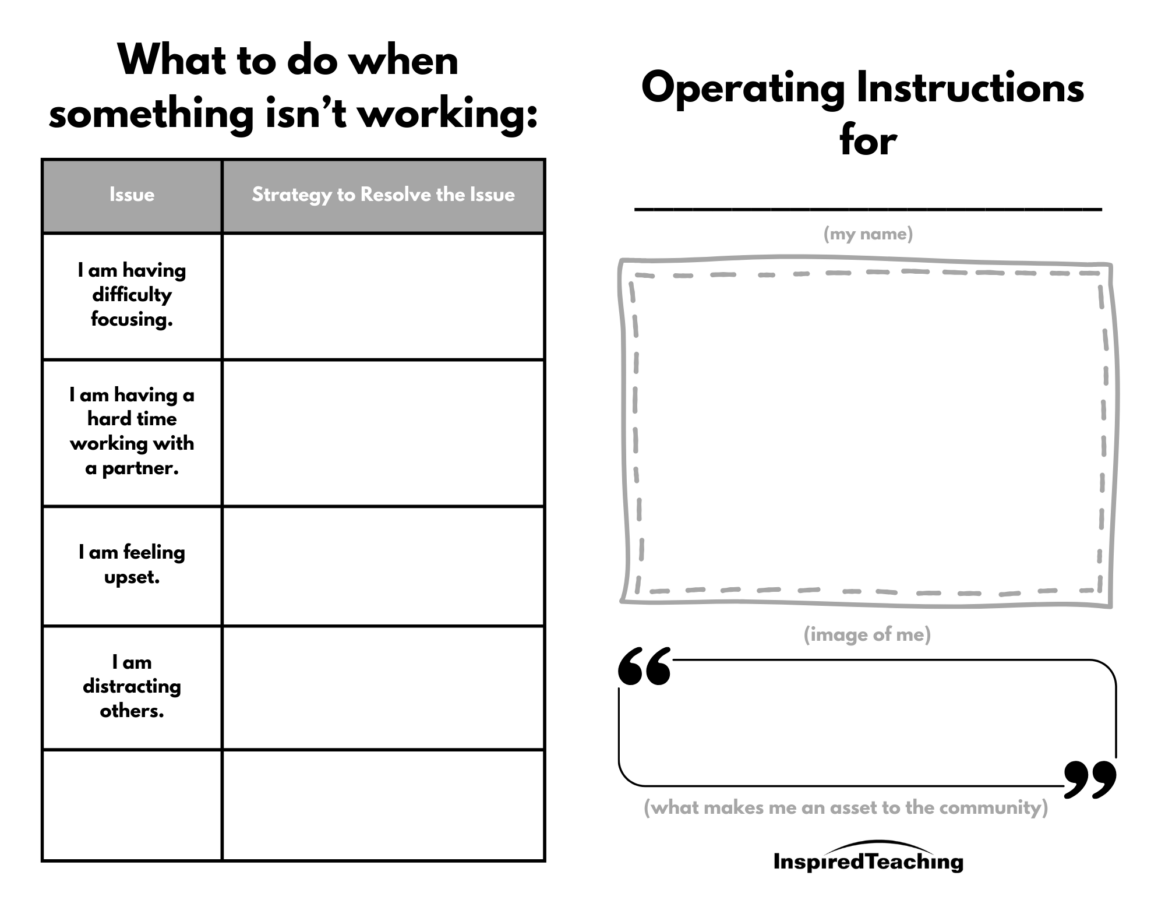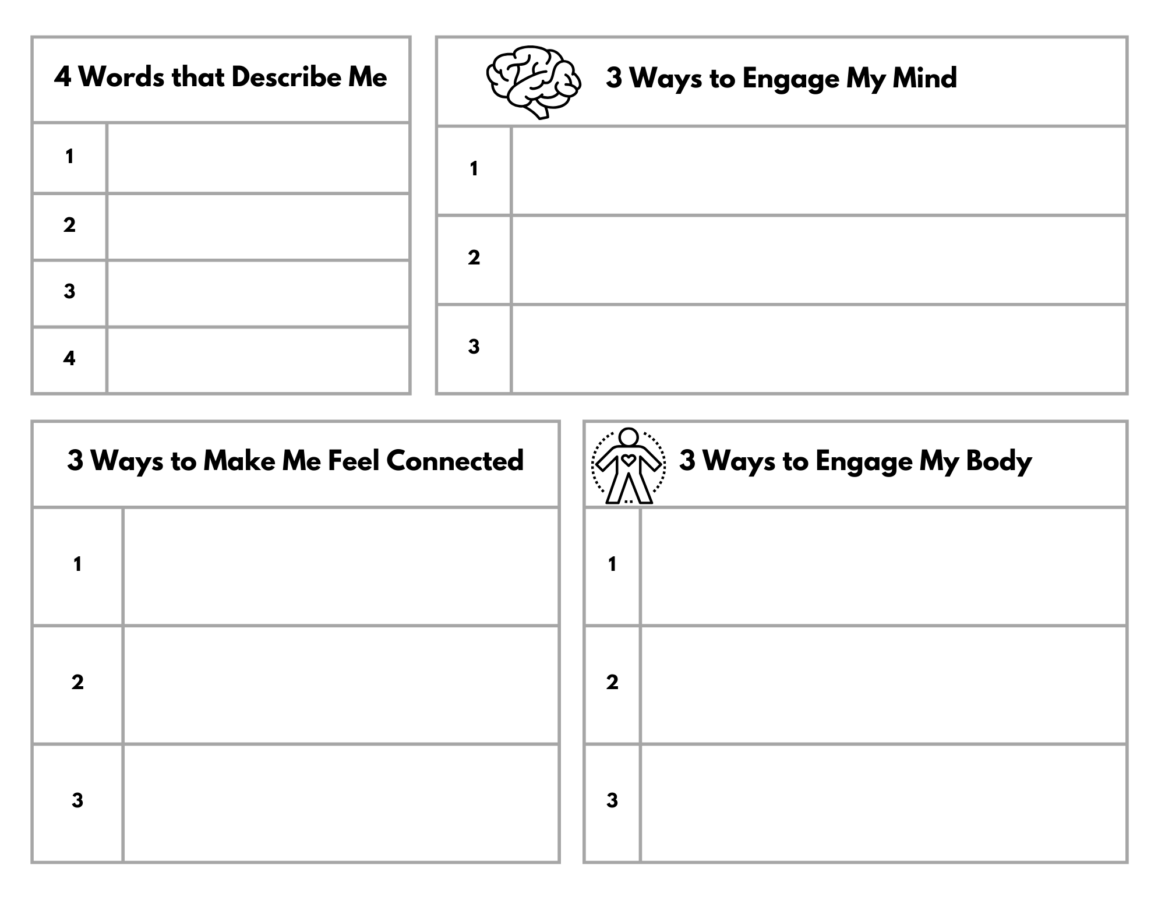If you try this activity with your students, we’d love to see what you do. Share your journey via the #Inspired2Learn hashtag on your preferred social platform.
Discipline: Applicable in all subjects.
Age level: K-12
Time: 1 Hour
Materials: Examples of operating instructions or manuals for various machines (ex. coffee machine, hair dryer, toaster, cell phone, electric toothbrush, etc.) and copies of the personal Operating Instructions handout for each student.
Created by: Jenna Fournel, Director of Teaching and Learning, Center for Inspired Teaching
For machines, operating instructions are created with knowledge of how something functions in its ideal and fully operational state, as well as practice with when it’s not working and testing fix after fix until you find the solution that gets things back in working order. Developing operating instructions for ourselves is much the same. It requires knowing what we are like, how we exist in the world when we are well and fully ourselves, and understanding what must be in place to help us feel that way.
This activity invites students to consider what their own operating instructions might look like, and in reflecting on this the students offer their teachers a valuable guide to meeting their needs.

What to do:
Have students study several machines and their operating instructions / user manuals. (As described above, these can be any kind of machine from a toaster oven to an electric drill. If you have lost the guides that go with these appliances you can generally find them online. Here is an example.) After they’ve explored several examples, generate a class brainstorm of what these guides include. You might instigate this discussion with questions like:
- From what you’ve observed, what is the purpose of these operating instructions / user manuals?
- What do they all seem to have in common? What is different?
- What do you notice about how the language is worded?
- What do you notice about the images?
- What did you notice about the “troubleshooting” or “problems” sections at the back of these guides?
After students have discussed these guides and settled upon their common features, shift the discussion to what operating instructions might look like for each student as an individual. Consider questions like:
- How do you know when you’re functioning at your best? How can other people tell?
- What kinds of things have to happen around you in order for you to be at your best?
- Considering all we discussed about the manuals for these machines, what might your own user manual have in common with the ones you just looked at?
- If you wrote operating instructions for yourself – who else might benefit from reading them? Why?
- In the back of your operating instructions, if you included the section for when problems occur, what kinds of issues might you include there?
- Are there more tools and strategies you need to help yourself when you’re not functioning at your best? What would you like to learn how to do?
Depending on the age of your students, it would be lovely for them to be able to create their own version of a manual – choosing the contents and the design. But that might take several class periods (even though it’s worth it!) and if you are limited in time, this handout can be folded into a little booklet and includes some key elements that will be helpful both for your students and for you as their teacher.
EXTENSION or PRE-WORK
We highly recommend building your students’ familiarity with the ABCDE of Learner Needs in conjunction with exploring their operating instructions. Students can gain a lot from using the ABCDEs – in fact, the framework itself becomes a tool in their personal wellness toolkit. If they are struggling and can diagnose what needs aren’t being met, the next step is figuring out HOW to meet them. And this is where creating their own operating instructions can come in handy.


Standards Addressed by this Activity
Common Core College and Career Readiness Anchor Standards for Language
Conventions of Standard English:
CCSS.ELA-LITERACY.CCRA.L.1 Demonstrate command of the conventions of standard English grammar and usage when writing or speaking.
Knowledge of Language:
CCSS.ELA-LITERACY.CCRA.L.3 Apply knowledge of language to understand how language functions in different contexts, to make effective choices for meaning or style, and to comprehend more fully when reading or listening.
Vocabulary Acquisition and Use:
CCSS.ELA-LITERACY.CCRA.L.4 Determine or clarify the meaning of unknown and multiple-meaning words and phrases by using context clues, analyzing meaningful word parts, and consulting general and specialized reference materials, as appropriate.
CCSS.ELA-LITERACY.CCRA.L.6 Acquire and use accurately a range of general academic and domain-specific words and phrases sufficient for reading, writing, speaking, and listening at the college and career readiness level; demonstrate independence in gathering vocabulary knowledge when encountering an unknown term important to comprehension or expression.
Common Core College and Career Readiness Anchor Standards for Writing
Text Types and Purposes:
CCSS.ELA-LITERACY.CCRA.W.2 Write informative/explanatory texts to examine and convey complex ideas and information clearly and accurately through the effective selection, organization, and analysis of content.
Production and Distribution of Writing:
CCSS.ELA-LITERACY.CCRA.W.4 Produce clear and coherent writing in which the development, organization, and style are appropriate to task, purpose, and audience.
Research to Build and Present Knowledge:
CCSS.ELA-LITERACY.CCRA.W.7 Conduct short as well as more sustained research projects based on focused questions, demonstrating understanding of the subject under investigation.
Common Core College and Career Readiness Anchor Standards for Speaking and Listening
Comprehension and Collaboration:
CCSS.ELA-LITERACY.CCRA.SL.2 Integrate and evaluate information presented in diverse media and formats, including visually, quantitatively, and orally.
Presentation of Knowledge and Ideas:
CCSS.ELA-LITERACY.CCRA.SL.6 Adapt speech to a variety of contexts and communicative tasks, demonstrating command of formal English when indicated or appropriate.
Common Core College and Career Readiness Anchor Standards for Reading
Key Ideas and Details:
CCSS.ELA-LITERACY.CCRA.R.1 Read closely to determine what the text says explicitly and to make logical inferences from it; cite specific textual evidence when writing or speaking to support conclusions drawn from the text.
Craft and Structure:
CCSS.ELA-LITERACY.CCRA.R.4 Interpret words and phrases as they are used in a text, including determining technical, connotative, and figurative meanings, and analyze how specific word choices shape meaning or tone.
CCSS.ELA-LITERACY.CCRA.R.5 Analyze the structure of texts, including how specific sentences, paragraphs, and larger portions of the text (e.g., a section, chapter, scene, or stanza) relate to each other and the whole.
Integration of Knowledge and Ideas:
CCSS.ELA-LITERACY.CCRA.R.7 Integrate and evaluate content presented in diverse media and formats, including visually and quantitatively, as well as in words.
CCSS.ELA-LITERACY.CCRA.R.9 Analyze how two or more texts address similar themes or topics in order to build knowledge or to compare the approaches the authors take.
Range of Reading and Level of Text Complexity:
CCSS.ELA-LITERACY.CCRA.R.10 Read and comprehend complex literary and informational texts independently and proficiently.
Common Core Standards for Mathematical Practice
Make sense of problems and persevere in solving them.
CCSS.MATH.PRACTICE.MP1 Mathematically proficient students start by explaining to themselves the meaning of a problem and looking for entry points to its solution. They analyze givens, constraints, relationships, and goals. They make conjectures about the form and meaning of the solution and plan a solution pathway rather than simply jumping into a solution attempt. They consider analogous problems, and try special cases and simpler forms of the original problem in order to gain insight into its solution. They monitor and evaluate their progress and change course if necessary. Older students might, depending on the context of the problem, transform algebraic expressions or change the viewing window on their graphing calculator to get the information they need. Mathematically proficient students can explain correspondences between equations, verbal descriptions, tables, and graphs or draw diagrams of important features and relationships, graph data, and search for regularity or trends. Younger students might rely on using concrete objects or pictures to help conceptualize and solve a problem. Mathematically proficient students check their answers to problems using a different method, and they continually ask themselves, “Does this make sense?” They can understand the approaches of others to solving complex problems and identify correspondences between different approaches.
Collaborative for Academic, Social, and Emotional Learning Competencies
Self-Awareness: The abilities to understand one’s own emotions, thoughts, and values and how they influence behavior across contexts. This includes capacities to recognize one’s strengths and limitations with a well-grounded sense of confidence and purpose.
Self-management: The abilities to manage one’s emotions, thoughts, and behaviors effectively in different situations and to achieve goals and aspirations. This includes the capacities to delay gratification, manage stress, and feel motivation and agency to accomplish personal and collective goals.
Social awareness: The abilities to understand the perspectives of and empathize with others, including those from diverse backgrounds, cultures, and contexts. This includes the capacities to feel compassion for others, understand broader historical and social norms for behavior in different settings, and recognize family, school, and community resources and supports.
Responsible decision-making: The abilities to make caring and constructive choices about personal behavior and social interactions across diverse situations. This includes the capacities to consider ethical standards and safety concerns, and to evaluate the benefits and consequences of various actions for personal, social, and collective well-being.
Relationship skills: The abilities to establish and maintain healthy and supportive relationships and to effectively navigate settings with diverse individuals and groups. This includes the capacities to communicate clearly, listen actively, cooperate, work collaboratively to problem solve and negotiate conflict constructively, navigate settings with differing social and cultural demands and opportunities, provide leadership, and seek or offer help when needed.
College, Career, and Civic Life (C3) Framework for Social Studies State Standards
| Dimension 1: Developing Questions and Planning Inquiries | Dimension 3: Evaluating Sources and Using Evidence |
|---|---|
| Developing Questions and Planning Inquiries | Gathering and Evaluating Sources |
| Developing Claims and Using Evidence |
